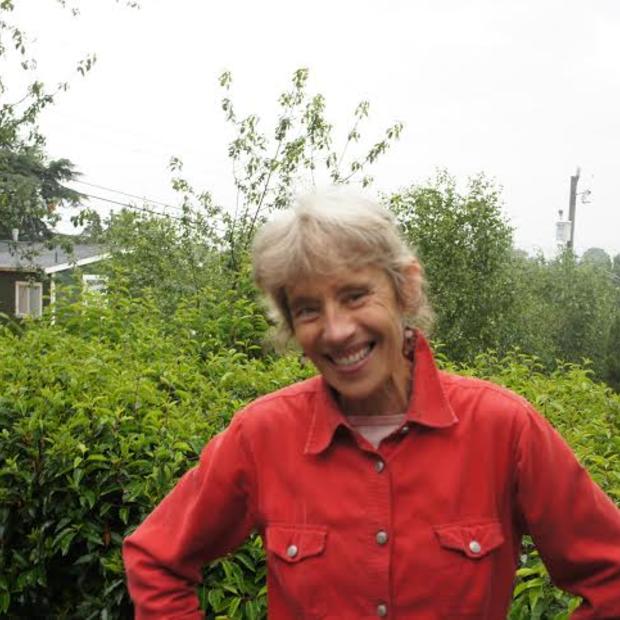“Tree ambassadors” guide a crowd through a corridor of streets with sixty varieties of trees: Gingko, Western White Pine, Pacific Madrone and six kinds of cedar. “The third tree is the Arborvitae in front of the Monkey Tree," says Philip Stielstra, one of the ambassadors leading the group.
"Where?"
"Right here. These tall, thin trees are called Arborvitae. Latin for tree of life.”
Stielstra is a “tree ambassador,” a project of the Green Seattle Partnership that hopes to empower residents to become stewards of the urban forest.
Click on the player above or here to listen to the audio version of this story.
This northeast neighborhood is unique. Trees are everywhere here compared to the average city canopy of 23 percent. For Stielstra and other “tree ambassadors” like Penelope Kriese, protecting and growing Seattle’s tree canopy is a tree hugging hobby with a mission.
“The real goal is to make people appreciate and plant trees, because the City of Seattle is trying to reach a 30 percent tree canopy. That means that over the next ten, fifteen years we need to plant 200,000 trees,” Kriese says. If you have an older tree, she suggests, plant a smaller one next to it. “By the time the big one dies, the smaller one is there. Think ahead. Don’t think right now. Be careful with how you take care of your trees. Plant them in the right places. Those are the things we want to educate people about.”
The timing of the tree walk coincides with the city’s plan to present a draft tree ordinance to the city council and the mayor. The intent, says Brennon Staley, Sustainable Communities Planner with the Department of Planning and Development, is to maintain and enhance a diverse and healthy urban forest. “We consider them an important green infrastructure element and we’ve done a lot of work to try and understand their specific contribution," he explains.
"Storm water is clearly one of the ones we understand the best," Staley says. "It’s also the benefit that has the largest financial contribution.” Roots of large trees in particular, absorb runoff from city streets and keep it underground instead of washing into urban waterways. “We’re also looking to be able to quantify their benefit for climate change, air pollution and health.”
But at a meeting with a group called Save the Trees-Seattle, Staley is under fire. The draft tree ordinance weakens tree protections, they say, and will result in further loss of urban tree canopy. “If we don’t build in protections for these trees now, what sort of message are we sending to our citizenry?" asks Save the Trees member Mark Solito. Solito says forty years ago the city’s tree canopy was 40 percent, compared to the current 23 percent. “I don’t see us getting back to even 30 percent unless the city makes a strong demand for a strong tree ordinance.”
The main points of contention between the tree ordinance drafted by the city’s Department of Planning and Development and a plan favored by Save the Trees- Seattle and tree ambassadors are these: The draft doesn’t protect trees smaller than 24 inches in diameter, including small natives like the Cascara and Pacific Dogwood. It doesn’t protect groves of trees, defined by some as four or more trees on a single property. Nor does it require mitigation when a tree larger than 20 inches in diameter is cut down and the responsible party isn’t required to plant replacements.
“Without having a permit system to tell people it's important to save trees, you’re telling them, by removing any limit on trees you can cut down under 24 inches, that trees aren’t really that important," says Steve Zemke with Save the Trees-Seattle, "People making their individual decisions are more important than protecting the urban forestry infrastructure.”
Brennon Staley, who was the point person assigned by the Department of Planning and Development to draft the new ordinance, acknowledges he has to weigh the interests of many shareholders — developers, homeowners keen on views, or those who want fewer trees so they can grow food. His job is also about helping to accommodate growth.
Seattle can push people into suburbia, says Staley, resulting in increased greenhouse gases, or build more multi-family housing in the urban core. “That is a really critical aspect of this. We can either choose to accommodate the people that are moving to the city or they’re going to go to the suburbs and urban fringe.” Both Staley and tree advocates agree on the ecosystem services trees provide – sequestering carbon, cleaning air and reducing storm water runoff.
What’s missing, says Seattle Audubon’s Matt Mega, is an accurate assessment of how many trees remain to do the job. Mega is setting up a database to assess tree canopy neighborhood by neighborhood. But, he says, “We’re not going to regulate our way out of this. We need to have people fall in love with trees and we need to have people understand that trees provide ecosystem services for us and that’s key.”
On a day when trees are both celebrated and fought for, it seems that some of Seattle’s trees, even one as unique as a Cucumber Tree, are having their say.
Green Acre Radio is brought to you with support from the Human Links Foundation. Engineering by CJ Lazenby.



